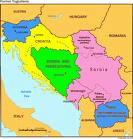NATO’s War against Yugoslavia was based on Lies

Germany joined the war against Yugoslavia under the pretense of fabricated facts. Sensational confession of German policeman Henning Hentz who served in the OSCE in Kosovo in the 90s confirmed that.
The reason here is that photographs taken by Hentz in late January 1999 were used by then German Defence Minister Rudolf Scharping to justify the immediate interference of NATO in the Kosovo conflict. He presented the photographs of the militants killed in Rugovo as photos of innocent Albanian victims.
What did really happen in Kosovo in late January of 1999, several months before NATO launched its operation against Yugoslavia?
According to Serbian sources, more than two dozen of Kosovo Liberation Army terrorists were killed in Rugovo, while the Western mass media insisted that at least nine of them were civilians. Particularly, the New York Times wrote with the reference to a local field commander that there were only four KLA militants in the village and he knew nothing about other people. January 29, on that day OSCE mission representative Henning Hentz was in Rugovo. He shared his impression of the visit with the Voice of Russia correspondent Iovanna Vukotic who gives a real picture of what happened. He said that this had nothing to do with the killing of Albanian civilians.
“We discovered 25 bodies, including 11 in a bus and some others near the vehicle. Several other bodies were laying in a barn which was used as a garage. The territory around the barn was covered with snow but there were no traces. I thought that the bodies were brought there from another location, and most likely, a day before the clash between Serb police and KLA militants,” Henning Hentz said.
At the time, German Defence Minister Rudolf Scharping showed only some of the photos taken by Henning Hentz and for some reason said those were taken by a German officer. He deliberately ignored the photos that clearly showed the dead bodies of KLA militants. So, Scharping managed to convince the public that “bad guys” or Serbs were again killing innocent Albanians and provoked a wave of refugees, says Hentz.
“For Germans, this meant that they would be involved in a military operation for the first time after the Second World War. My impression is that the situation in Kosovo at the time was exaggerated. When I visited Kosovo, there was no necessity for Albanians to leave their homes en mass. A real exodus started with the beginning of bombing. A major part of the report on the Kosovo situation was exaggerated and was always against Serbs,” Henning Hentz added.
Ethnic cleansing in Kosovo was used as a pretext for bombing Yugoslavia. And the incident in the village of Rugovo shows once again that the PR campaign against Belgrade was organized using obvious forgeries. Reportedly, NATO started thinking about an invasion after the killing of 40 civilian Albanians in Rachak. However, experts who studied the forensic reports concluded that there was no evidence proving that the killed were civilians, and that they were killed by Serbian servicemen.
This technology is being used even now. For example, the photos taken in Iraq in 2003 are used in news broadcasts to show the deaths of Syrian civilians. The dramatic effect is achieves by using photo editing programmes. For example, a Syrian family walking in the streets of an ordinary city, photo is shown on a background of ruined buildings. Ultimately, they achieve the necessary effect. In the 19th century, a prominent Russian gnomic poet Kozma Prutkov said: If you read the world buffalo on a cell of an elephant, please, do not believe it. Truly, in the 19th century, there was no high-tech to make a fly from an elephant as well as genocide from contract killing.

